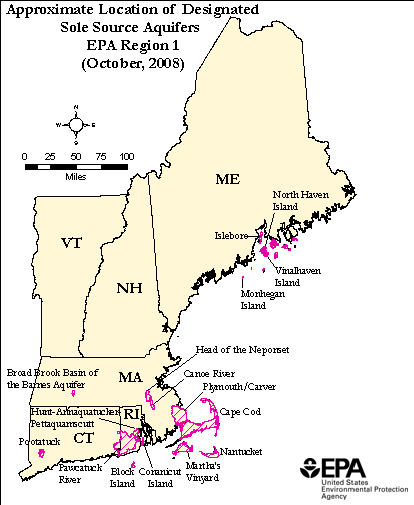Sole Source Aquifer Program
The Safe Drinking Water Act gives EPA the authority to designate aquifers which are the sole or principal drinking water source for an area, and which, if contaminated, would create a significant hazard to public health. After a Sole Source Aquifer is designated, no commitment for federal financial assistance may be provided for any project which the EPA determines may contaminate the aquifer through its recharge area so as to create a significant hazard to public health. An additional benefit of designating an area as a Sole Source Aquifer is the increased public awareness of the nature and value of local ground water resources. Local residents and businesses may be more willing to protect an aquifer through local action if they learn their drinking water originates from a vulnerable underground supply.
The EPA defines a Sole Source Aquifer as one which supplies at least 50% of the drinking water consumed in the area overlying the aquifer. EPA guidelines also require that these areas have no alternative drinking water sources(s) which could physically, legally, and economically supply water to all who depend on the aquifer for drinking water.
As of August 2008, a total of 16 Sole Source Aquifers (one aquifer crosses two states) have been designated by the EPA Region 1, New England Office. There are no potential designations pending at this time:
Massachusetts:
- Broad Brook Basin of the Barnes Aquifer
- Canoe River
- Cape Cod
- Head of the Neponset
- Martha's Vineyard
- Nantucket
- Plymouth/Carver
Connecticut:
Rhode Island:
Maine:
Vermont:
- None designated
New Hampshire:
- None designated
View individual aquifers by clicking the aquifer name.

Any individual, corporation, company, association, partnership, state, municipality or federal agency may apply to have a Sole Source Aquifer designated. In 1987, EPA published the Sole Source Aquifer Designation Petitioner Guidance to assist those interested in preparing and submitting petitions to EPA regional offices. View the petitioners guidance online and learn about national efforts to protect Sole Source Aquifers.
Once designated, proposed federal financially-assisted projects which have the potential to contaminate the aquifer are subject to EPA review. Proposed projects that are funded entirely by state, local, or private concerns are not subject to EPA review through the program. Examples of federally funded projects which have been reviewed by EPA in New England include:
- highway improvements and new road construction
- airport improvements
- transportation stations and maintenance facilities
- new construction of rail lines
- large wastewater treatment facilities
- projects funded through Community Development Block Grants
- large residential developments funded through the Rural Utilities Service
- water system improvements
EPA has developed Memorandum of Understandings with other federal agencies which specify review responsibilities under the Sole Source Aquifer program. Many projects referred to EPA for review meet all federal, state and local ground water protection standards and are approved without any modification. If projects are determined to pose a significant risk of contamination, EPA may make specific recommendations or require modifications as a condition of federal funding. Federal funding can be denied if a project will pose a significant threat of contamination to a Sole Source Aquifer and an applicant is unwilling to make necessary project modifications to reduce its risk of contamination.
Other Information Sources
- Program Factsheet
- Petitioners Guidance
- Map of Sole Source Aquifer Locations in New England with Links to Individual Maps and Their Federal Register Notices
- Sole Source Aquifers for Drinking Water
- Contact EPA Region 1, NE Office for Further Information
- Source Water Protection - Best Management Practices
